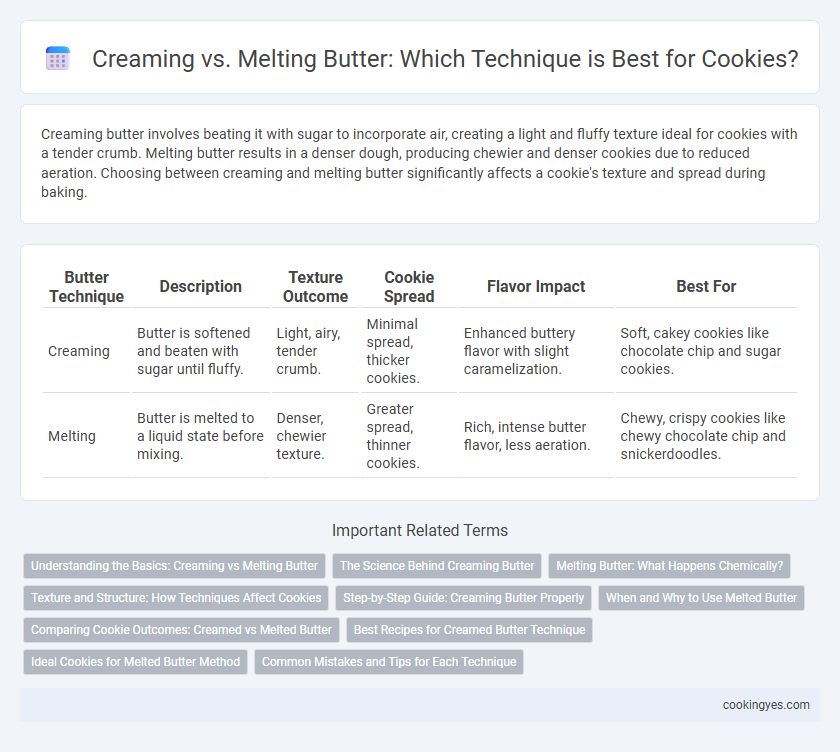Creaming butter involves beating it with sugar to incorporate air, creating a light and fluffy texture ideal for cookies with a tender crumb. Melting butter results in a denser dough, producing chewier and denser cookies due to reduced aeration. Choosing between creaming and melting butter significantly affects a cookie's texture and spread during baking.
Table of Comparison
| Butter Technique | Description | Texture Outcome | Cookie Spread | Flavor Impact | Best For |
|---|---|---|---|---|---|
| Creaming | Butter is softened and beaten with sugar until fluffy. | Light, airy, tender crumb. | Minimal spread, thicker cookies. | Enhanced buttery flavor with slight caramelization. | Soft, cakey cookies like chocolate chip and sugar cookies. |
| Melting | Butter is melted to a liquid state before mixing. | Denser, chewier texture. | Greater spread, thinner cookies. | Rich, intense butter flavor, less aeration. | Chewy, crispy cookies like chewy chocolate chip and snickerdoodles. |
Understanding the Basics: Creaming vs Melting Butter
Creaming butter involves beating it with sugar to create a light, fluffy texture that traps air for tender, airy cookies, while melting butter results in denser, chewier cookies due to the lack of incorporated air. The choice between creaming and melting butter affects cookie spread, texture, and flavor release, with creaming promoting structure and melting enhancing moisture. Understanding these techniques allows bakers to control crumb consistency and achieve desired cookie outcomes.
The Science Behind Creaming Butter
Creaming butter involves beating softened butter with sugar to incorporate air, creating tiny air pockets that aid in leavening and produce a light, fluffy cookie texture. This technique enhances gluten development by evenly distributing fat, which slows gluten formation and results in tender cookies. Melting butter, in contrast, eliminates air incorporation and yields denser, chewier cookies by altering the dough's moisture distribution and reducing leavening effects.
Melting Butter: What Happens Chemically?
Melting butter breaks down its solid fat crystals, allowing the fat to integrate more uniformly into cookie dough, which results in a denser and chewier texture. Chemically, melting transforms the butter's fat molecules, reducing aeration potential compared to creaming, thus limiting the amount of trapped air in the dough. This process also affects the way sugar dissolves and interacts with flour proteins, influencing gluten development and ultimately the cookie's tenderness.
Texture and Structure: How Techniques Affect Cookies
Creaming butter and sugar incorporates air into the dough, resulting in lighter, fluffier cookies with a tender crumb and delicate structure. Melting butter before mixing produces denser, chewier cookies with a fudgier texture due to the increased moisture absorption by the flour. Understanding the impact of these techniques on cookie texture allows bakers to tailor recipes for either soft, airy treats or rich, chewy bites.
Step-by-Step Guide: Creaming Butter Properly
Creaming butter properly involves beating softened butter with sugar until the mixture becomes light, fluffy, and pale in color, which typically takes about 3 to 5 minutes using an electric mixer on medium speed. This technique incorporates air into the batter, essential for achieving tender, well-risen cookies with a delicate crumb. Avoid melting butter in this step, as melted butter results in denser, chewier cookies due to lack of aeration.
When and Why to Use Melted Butter
Melted butter is ideal for cookies that require a denser, chewier texture, such as chocolate chip or oatmeal cookies, because it allows the dough to spread more during baking. This technique is used when a softer, more tender crumb is desired, as melted butter coats flour proteins differently than creamed butter, reducing gluten formation. Choosing melted butter also speeds up mixing and enhances flavor absorption, making it perfect for recipes prioritizing chewiness over fluffiness.
Comparing Cookie Outcomes: Creamed vs Melted Butter
Cookies made with creamed butter typically have a lighter, fluffier texture and a more complex flavor due to the incorporation of air during the creaming process, which enhances leavening and crumb structure. In contrast, cookies baked with melted butter yield a denser, chewier texture and a richer, sometimes more intense butter flavor because the fat coats flour proteins differently, reducing gluten development. Choosing between creamed and melted butter affects not only texture but also spread and moisture retention, influencing the final cookie's bite and shelf life.
Best Recipes for Creamed Butter Technique
Creamed butter technique involves beating softened butter with sugar until light and fluffy, which creates air pockets essential for a tender, airy cookie texture. Best recipes that utilize creamed butter include classic chocolate chip cookies, sugar cookies, and snickerdoodles, where the creaming process ensures proper leavening and a soft crumb. This method contrasts with melting butter, which typically results in denser, chewier cookies, highlighting the creamed butter technique's role in achieving optimal cookie softness and rise.
Ideal Cookies for Melted Butter Method
Melted butter creates denser, chewier cookies with a rich, fudgy texture ideal for chocolate chip or peanut butter varieties. This method enhances moisture retention and allows sugar to dissolve effectively, resulting in a softer bite and spread. Cookies made with melted butter typically develop crispier edges while maintaining a tender center, perfect for achieving that desirable contrast.
Common Mistakes and Tips for Each Technique
Creaming butter involves beating it with sugar until light and fluffy, but common mistakes include using butter that is too cold or overmixing, which can result in dense cookies. Melting butter requires precise temperature control; overheating can cause greasy, flat cookies, while slightly cooled melted butter enhances chewiness. To optimize results, use softened butter for creaming and melt butter gently before cooling slightly to maintain desired cookie texture and structure.
Creaming vs Melting for butter technique Infographic

 cookingyes.com
cookingyes.com